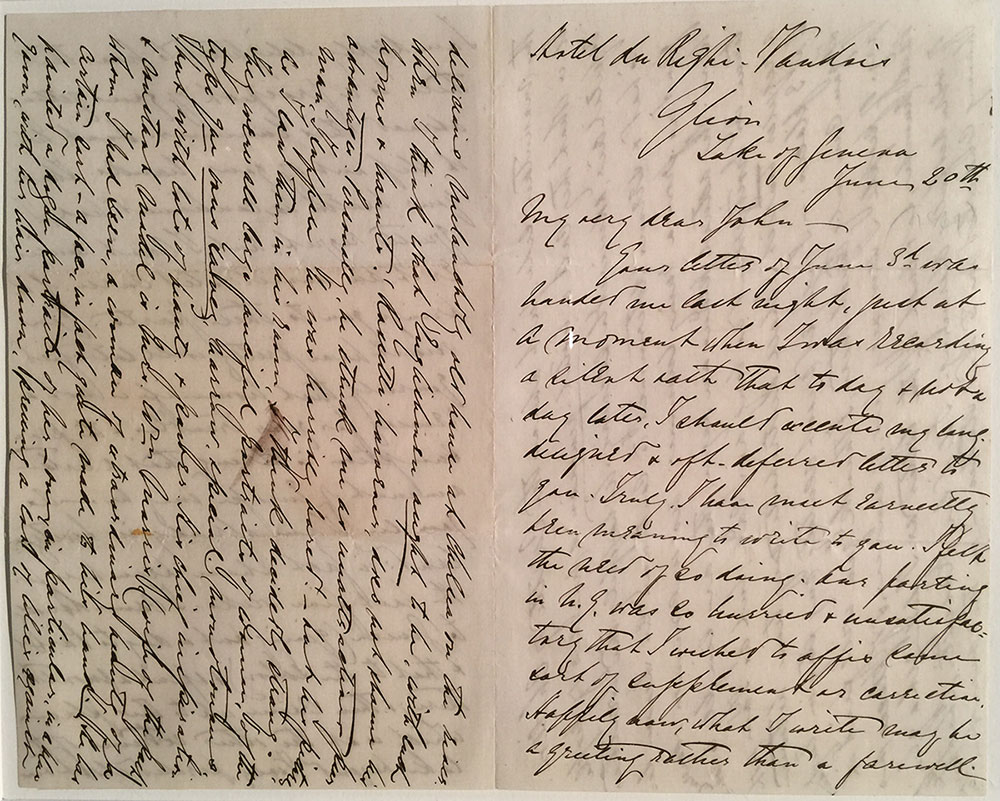 Henry James (1843–1916)
Henry James (1843–1916)
Autograph letter, signed, to John La Farge, 20 June 1869
Lent by the New-York Historical Society, La Farge Papers, New York; ms 360.
Writing from Lake Geneva in the summer of 1869, James recounted his recent rst visit to England. There, he had met Dante Gabriel Rossetti in his studios, seen the work of Edward Burne-Jones, and visited the National Gallery in London. James admired Titian’s Bacchus and Ariadne, which he called “a thing to go barefoot to see!” About Titian’s Ariosto, James wrote: “Ah, John! what a painter. For him, methinks, I’d give all the rest.” While in England, James’s friend Charles Eliot Norton took him to meet the “very amiable” John Ruskin, whose art criticism had deeply impressed James. Ruskin showed James his collection of works by Turner, though James admitted to La Farge that “I think I prefer Claude. He had better taste, at any rate.”
Henry James to John La Farge
Glion, Lake of Geneva, June 20th [1869]
Verso: I did see Rossetti, Chas. Norton having conducted me to his studio—in the most
Recto: delicious melancholy old house at Chelsea on the river. When I think what Englishmen ought to be, with such homes & haunts! Rossetti however, does not shame his advantages. Personally, he struck me as unattractive—poor man, I suppose he was horribly bored!—but his pictures, as I saw them in his room, I think decidedly strong. They were all large fanciful portraits of women, of the type que vous savez, narrow, special, monotonous, but with lots of beauty & power. His chief inspiration & constant model is Mrs. Wm. Morris, [wife of the poet] whom I had seen, a woman of extraordinary beauty of a certain sort—a face, in fact quite made to his hand. He has painted a dozen portraits of her—one, in particular, in a blue gown, with her hair down, pressing a lot of lilies against
Verso: her breast—an almost great work.
A letter from Henry James to John La Farge,
Lyon, Lake of Geneva, June the 20th, 1869.
I did see Rosetti. Charles Norton having conducted me to his studio—in the most delicious, melancholy old house at Chelsea on the river. When I think what Englishmen ought to be, with such homes and haunts! Rosetti, however, does not shame his advantages. Personally, he struck me as unattractive—poor man, I suppose he was horribly bored!—but his pictures, as I saw them in his room, I think decidedly strong. They were all large, fanciful portraits of women of the type que vous savez, narrow, special, monotonous, but with lots of beauty and power.
His chief inspiration and constant model is Mrs. William Morris, whom he had seen a woman of extraordinary beauty of a certain sort—a face, in fact, quite made to his hand. He has painted a dozen portraits of her—one in particular in a blue gown with her hair down, pressing a lot of lilies against her breast—an almost great work.
